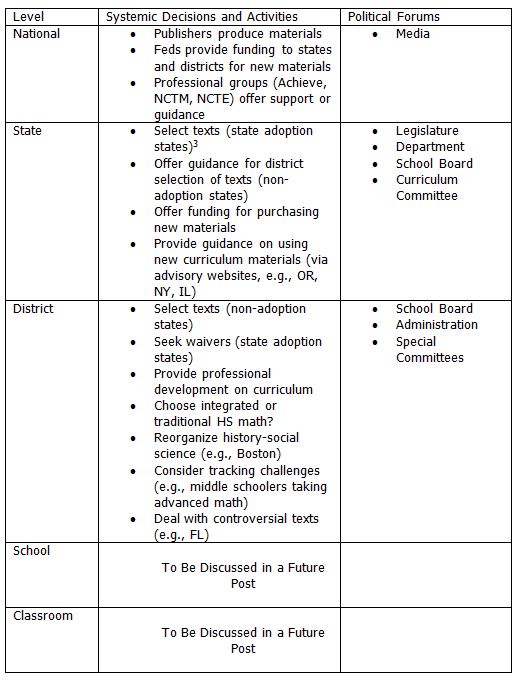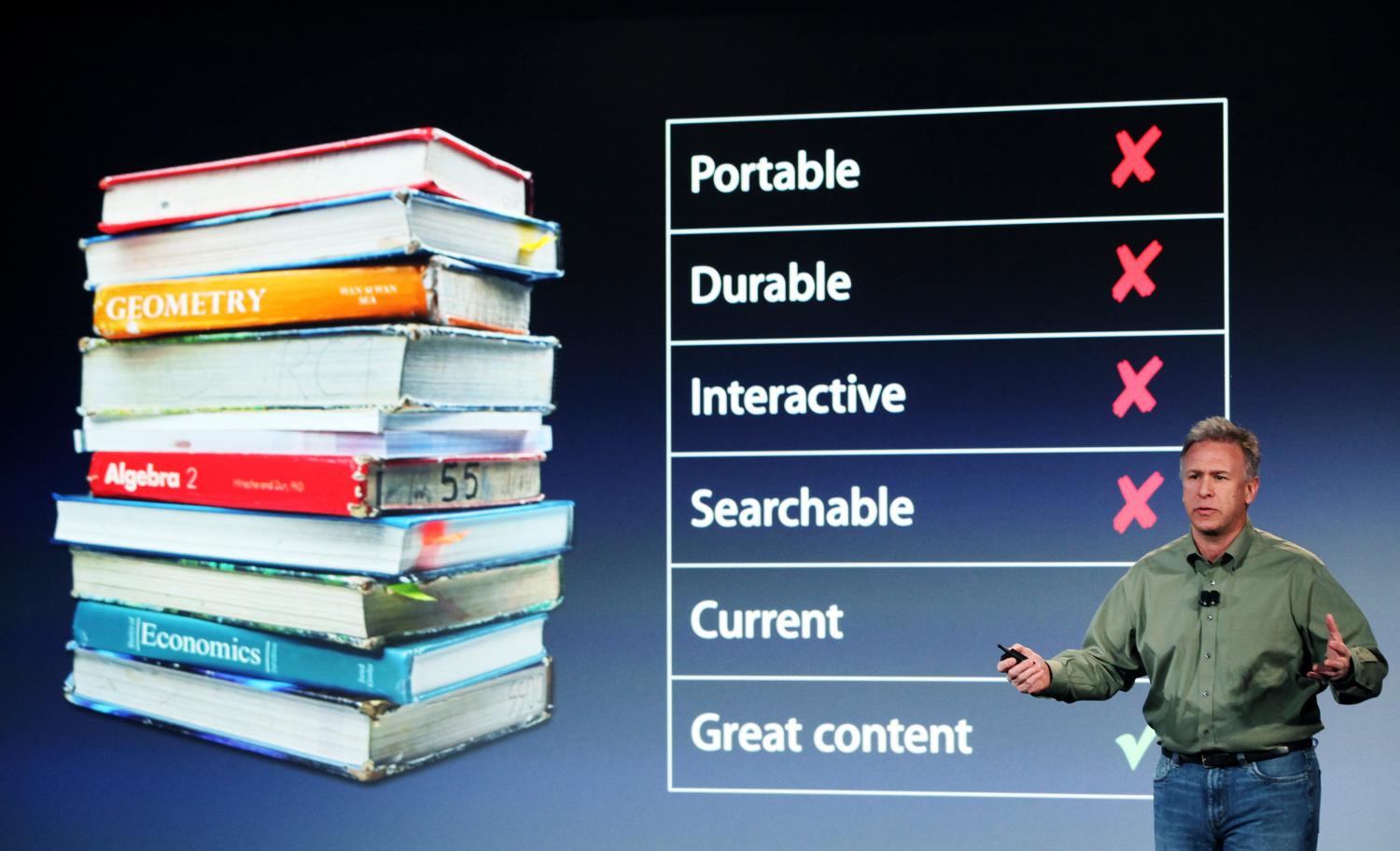In my May Chalkboard post, I presented Pressman and Wildavsky’s classic implementation model as a guide to analyzing the implementation of the Common Core State Standards (CCSS). With policies that span multiple layers of governance, decision points at every level influence the fate of implementation. Negotiating each level of governance also leaves policies vulnerable to attack by political opponents. When 45 states and the District of Columbia initially adopted the Common Core and the federal government supported the effort through Race to the Top funding, the initiative’s opponents did not simply roll up their tents and disappear. They reorganized in several states to launch new battles, and are now preparing to fight in many districts as well.
In this essay, I continue the analysis of curriculum’s role in implementing CCSS. I discuss key curricular decisions that will be encountered as CCSS makes its way through the school system, and the potential political controversies that this process may provoke. There are two pathways that analysts must pay attention to while tracking CCSS’s implementation, one systemic and the other political. The systemic path mostly comprises the activities of education’s “insiders”—educators, officials, publishers—whose daily work routinely shapes curriculum.[1] The political path focuses primarily on “outsiders,” in particular, the forums where CCSS’s opponents can try to influence, and perhaps even block, implementation.
Throughout the history of American education, when reformers’ pet ideas have failed, the failure has been laid at the feet of “poor implementation.” Rarely is implementation defined, or the vast policy literature on implementation cited, so that one can determine what exactly led to the policy’s demise.[2]
In my May Chalkboard post, I defined implementation of the CCSS as: the decisions that educators make—at national, state, district, school, and classroom levels—to realize the curriculum, instruction, assessment, and accountability systems of the Common Core. Let’s apply the definition more specifically to curriculum. Curriculum is the “stuff” of learning, the content of what is taught in school—especially as embodied in the materials used in instruction. Table 1 exhibits an overview of activities that will be key to implementing curriculum under the Common Core. The activities encompass how educators (or education officials) produce, select, and organize instructional materials in accordance with the Common Core.
The table’s entries stop at the district level. The next Chalkboard post in this series will discuss the implementation of curriculum in schools and classrooms.
Table 1: Activities Key to the Implementation of CCSS

National
National efforts to implement CCSS curricula have been underway since the standards were first written and states adopted them. Publishers have produced materials that they claim are aligned with CCSS, although two recent reviews have questioned that claim.[4] The federal government provided funds supporting new materials through Race to the Top, the Investing in Innovation Fund (I3), and Title I programs. Professional groups of educators (e.g., NCTM, NCTE), as well as non-educators (e.g., Achieve), have designed websites and issued publications offering guidance on curriculum.
The U.S. Department of Education supports the CCSS while Congress has stayed mostly silent. The key political forum to watch now at the national level is the media, including social media. Public opinion on CCSS is malleable; polls indicate about half of the American people have never heard of Common Core.[5] In the past few months, math problems attributed to the CCSS were ridiculed on television by comedians Louis CK and Stephen Colbert. Fairly or unfairly, becoming the butt of jokes cannot enhance the public’s perceptions of Common Core curriculum. How the public comes to view the CCSS will play a role in dictating its fate.
State
In twenty states textbooks are adopted for all districts at the state level.[6] The word “textbook” here refers to curricular programs comprising both digital and hard copy materials, including supplementary workbooks, worksheets, and games, as well as formative and summative assessments. State adoption states, as they are called, typically identify the programs that local districts may purchase using state funds. The remaining states give districts greater latitude in selecting materials, although even these states frequently issue guidance on selection (note that in the table’s mention of states’ advisory websites, Oregon is a state textbook adoption state, but New York and Illinois are not). Most states have already been working on implementing CCSS curriculum for a few years. In a 2011 survey, the U.S. Department of Education found that twenty-nine states had “provided instructional materials or curriculum assistance for the CCSS.”[7] In a 2013 survey conducted by the Center for Education Policy at George Washington University, thirty states reported that CCSS-aligned curricula were currently in use in classrooms, with nine more states slated to begin in 2013-2014.[8]
District
As mentioned above, recent academic reviews of textbooks have questioned publishers’ claim that materials are aligned with the Common Core. William Schmidt of Michigan State University called the assertion a “sham” and according to Education Week, “dismissed most purveyors of such claims as ‘snake oil salesmen’ who have done little more than slap shiny new stickers on the same books they’ve been selling for years.”[9] Schmidt’s team of researchers reviewed 35 textbook series.
Local educators seem to view alignment differently. Seattle Public Schools managed to find four finalists for the 2014 K-5 math adoption, even though alignment with CCSS was an ironclad requirement.[10] California’s 2014 K-8 math adoption includes 20 approved texts. The selection process was legislatively mandated (AB 1246) to choose only curriculum materials aligned with the CCSS.[11] Districts will now pick from among these state approved programs. Obviously, well-informed people can disagree on what constitutes alignment. It’s also important to note that one of California’s state-approved programs, Connected Mathematics, encountered strenuous opposition in several of the state’s districts when it was introduced in the 1990s. That legacy, and memories of the “math wars” that still linger in many communities, surely could influence decisions made today about math curricula.
In addition to selecting curriculum and offering professional development on its use to teachers and principals, districts decide how to organize curriculum and students into instructional units. The match of students and curriculum—deciding who takes what and when they take it—has a long history of controversy in middle and high schools.
Table 1 lists three decisions concerning how to organize curriculum that local educators face in implementing the Common Core: reorganizing history and social science, deciding between integrated or traditional high school math, and tracking middle schoolers who take advanced math. In Boston, district leaders received sharp criticism when it was thought that they had decided to abolish history-social science departments and combine them with English-language arts. Faced with backlash and petitions[12] against the policy, the Superintendent issued a statement clarifying the district plan for “improving and coordinating the use of instructional materials throughout all subject areas” by bringing separate history and social studies, English language arts, and world languages departments together under the “humanities umbrella.”[13] This was in response to the Common Core calling for students to read more non-fiction texts and schools to incorporate historical documents into literacy instruction. The decision also comports with a longstanding strain of reform seeking to integrate traditional subject areas into multi-disciplinary courses; combining history and ELA, for example, is often an initial target of integration.
A second decision also involves curriculum integration but applies exclusively to high school mathematics. Most countries other than the U.S. do not teach high school math in courses organized by topic (Algebra, Geometry, etc.) but instead integrate topics into a sequence of single year courses (Math 1, Math 2, etc.). Integrated math remains an exotic course option in the U.S. Only two percent of 12th graders in the 2013 National Assessment of Educational Progress (NAEP) said they were taking an integrated Math 4 course in 12th grade. Only three percent of these same twelfth graders reported that they took an integrated Math 3 course in 11th grade, and four percent reported taking an integrated Math 2 course in 10th grade. American math reformers have long dreamed of joining European and Asian high schools in offering a sequence of integrated high school math courses. The idea has never taken hold. Common Core furnishes an opportunity to advance this idea.
The authors of the Common Core math standards wrote two sets of standards for high school, one for the traditional sequence and one for integrated math. By treating both approaches as if they have equal standing—regardless of the overwhelming relative popularity of the traditional sequence—the CCSS cannot help but be regarded as prying open a window for integrated math courses. The nation’s schools have evidenced a lopsided preference for the traditional sequence, but the two approaches are granted parity in the Common Core. Neutrality, in this case, is a tacit endorsement. And it carries significant consequences for implementation. State, district, and school administrators who have long wished and waited for an integrated sequence of math courses are licensed to push this approach as a “reform” sanctioned by the CCSS.
Integrated math isn’t new. How have previous attempts fared in implementation? Not well. The most recent case comes from the state of Georgia. The state began easing towards integrated math as the preferred high school sequence in 2004 and pushed districts to implement it by 2009. Many resisted, and a statewide debate (and irony) ensued. By 2011, Georgia school districts started going back to the traditional sequence, with some districts citing the Common Core as their rationale.[14] At the same time, districts in other parts of the country were citing Common Core as a reason for converting to integrated math. The Santa Barbara Unified School District, for example, adopted the integrated sequence in 2014.[15]
The third decision that districts face involves tracking. How will differentiation occur within a core curriculum that is ostensibly “common” to all students? Taking Algebra I in eighth grade or earlier, a practice that has become increasingly popular since the 1990s, is a sticking point with CCSS. The CCSS math standards include many algebra topics at eighth grade, but do not offer a formal course in Algebra I until ninth grade. Williamson Evers, Sandra Stotsky, and Ze’ev Wurman are among those opposing Common Core for, among other objections, retreating from the eighth grade algebra course.[16] On the 2013 NAEP, 43 percent of eighth graders reported that they were taking an algebra course and five percent were enrolled in geometry, presumably having taken Algebra I in seventh grade. Thus, about half of all students are affected, and they include the nation’s highest achievers in mathematics.[17] How will districts modify the curriculum serving middle school high achievers and still adhere to the CCSS?
The CCSS describes “compacted” and “accelerated pathways” (see Appendix A in CCSS) that would allow students to complete Algebra I by the end of eighth grade, but it’s unclear, especially if students then take integrated courses in high school, how this will all mesh to form a coherent course of study. The CCSS makes no mention at all of accommodating students who complete Geometry before ninth grade. The challenge of providing courses for accelerated students is not new, of course, so it is not that the CCSS created this problem. But it does force districts to reconsider the manner in which they have ordered existing curriculum into a sequence of courses, and by doing so, may rekindle political battles that were fought years before—and settled by districts’ current course offerings.
Conclusion
In this post, I have traced the implementation of Common Core curriculum from the national to the district level. A future post will focus on implementing CCSS curriculum in schools and classrooms, and additional posts will analyze the implementation of CCSS’s other key policy dimensions—instruction, assessment, and accountability—following the same analytical strategy of examining how they are implemented down through the educational system.
In terms of curriculum’s role in implementing the Common Core, three overarching conclusions can be drawn from the foregoing analysis.
- Implementers at different levels of the system will interpret the CCSS differently, introducing variation into how the Common Core is perceived and experienced. The way in which “alignment” of curriculum with CCSS can be evaluated differently by state and district textbook adopters, not to mention academic reviewers, illustrates that point. Moreover, the CCSS math standards are a compromise, reflecting positions of both camps in the 1990s math wars: math reformers (e.g., students will learn multiple ways of solving the same problem) and math traditionalists (e.g., students will learn the standard algorithm). By the time the CCSS curriculum reaches classrooms, it may not look like the hybrid approach it appears to be in writing. The changes will occur as educators produce, select, and organize instructional materials—the routine curricular decisions that are made within the system.
- As a top-down policy, CCSS will weaken as it moves to lower stages in the system. The political implications of Pressman and Wildavsky’s implementation model are revealing here. The weakening occurs not only because of the multiple decision points that the policy must clear, but also because each level of the system is democratically governed, introducing new actors and interests into the policy’s fate. Opponents resurface. Local political environments may be hostile. Each level has its own political history, too, meaning that controversial math texts from the 1990s will be received differently in districts that fought bitter political battles over programs two decades ago. Selecting a particular novel for the new Common Core high school ELA curriculum may be warmly received in some districts—and found objectionable in others.
- Much of what I have described here is negative for implementing the Common Core. The American school system is structured in such a way as to make the implementation of top-down policies very difficult. But it’s not impossible. Indeed, I spent most of the 1990s studying the implementation of a single policy—detracking—that two states (Massachusetts and California) urged districts and schools to follow. I found many cases where districts and schools followed the states’ recommendations, offering hope for top-down implementation of education policy. One of the goals of this series of posts will be to uncover and to analyze the local conditions favoring CCSS’s implementation.
[1] An alliance of inside-outside political actors with shared interest in a particular policy is often called a “policy network.” For a discussion of policy networks promoting 1960s’ and 1990s’ math reforms see The Great Curriculum Debate (Loveless, 2001).
[2] http://excelined.org/2014/06/16/open-letter-patricia-levesque-accountability-drives-results/
[3] States in which textbooks are adopted for all districts at the state level by the department of education or board of education are called “state adoption states”. I refer to states in which this is not the case as “non-adoption states.”
[4] http://www.edweek.org/ew/articles/2014/03/05/23textbooks_ep.h33.html
[5] http://blogs.edweek.org/edweek/curriculum/2014/06/new_poll_finds_httpmsnbcmediam.html
[6] http://www.afb.org/info/programs-and-services/professional-development/solutions-forum/state-adoption-of-textbooks/1235 An analysis of the politics of textbook adoption is offered in Wong and Loveless (1991).
[7] Ann Weber, et al., State Implementation of Reforms Promoted Under the Recovery Act (USDOE, 2014). http://ies.ed.gov/ncee/pubs/20144011/
[8] http://www.huntintersection.com/2013/10/03/ten-big-takeaways-from-ceps-research-on-state-implementation-of-the-common-core/
[9] http://www.edweek.org/ew/articles/2014/03/05/23textbooks_ep.h33.html
[10] The district selected “Math in Focus” (Singapore math) but is now embroiled in controversy over a school waiver process that may allow schools to adopt “enVision Math”, the second place finisher.
[11] http://www.cde.ca.gov/ci/ma/im/documents/mathadoptionrpt2014.pdf
[12] http://www.change.org/petitions/mayor-martin-j-walsh-reinstate-the-department-of-history-social-studies-as-a-core-academic-content-discipline-in-the-boston-public-schools?recruiter=177161&utm_campaign=twitter_link_action_box&utm_medium=twitter&utm_source=share_petition%20via%20@Change
[13] http://www.bostonpublicschools.org/site/default.aspx?PageType=3&DomainID=4&ModuleInstanceID=14&ViewID=047E6BE3-6D87-4130-8424-D8E4E9ED6C2A&RenderLoc=0&FlexDataID=4091&PageID=1
[14] The Atlanta Journal-Constitution covered the debate. Be sure to read Maureen Downey’s columns on the controversy. http://www.ajc.com/news/news/local/integrated-math-could-be-out-in-high-schools/nQM6Y/
[15] http://www.cta.org/en/Media-Coverage/In-the-News/2014/01/20140116_3.aspx
[16] http://www.usnews.com/news/special-reports/articles/2014/02/25/the-common-core-math-standards-content-and-controversy
[17] NAEP Data Explorer. http://nces.ed.gov/nationsreportcard/about/naeptools.asp



